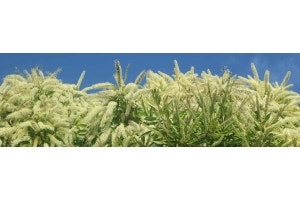

Geraldton waxflowers - Chamelaucium - are such an iconic part of the Aussie landscape, and our home gardens.
These big airy lemony-scented shrubs, with slender almost leaf-less branches, have travelled around the world in florist bouquets, spreading the word about Australian native plants.Waxflowers' distinctive five-petalled flowers come in a wide range of pastel shades from pure white, through pale pink to musk pink, lolly pink, magenta and purple.
Most waxflowers flower from winter into spring, and even early summer depending on the local climate and weather.
You can plant them almost all year round, apart from high summer heatwaves.

Waxflowers Love Drier Climates
Geraldton waxflowers can be quite fussy garden plants, even though they are natives.Give them the right conditions and you'll have a better chance of them thriving in your garden.
Native Chamelaucium species originate from the south-west part of Western Australia, where the climate is dry and hot, and usually frost free. You'll also find them growing naturally, and in commercial plantations, along the southern coast in South Australia and Victoria. There's over a dozen different species but the most commonly grown in our gardens are cultivars of Chamelaucium uncinatum. The related species Chamelaucium megalopetalum - big petal - is currently being used to develop larger-flowered new hybrids in more compact sizes.
If you live in a humid climate, you can still grow waxflowers.
- Site them somewhere airy and open, with cross breezes.
- They even do well at the coast if the wind isn't too strong
- Give them plenty of space around each plant.
- Water into the soil, rather than over the plant; and don't overwater
- If you notice black spots on the leaves, spray with fungicide
- Choose newer named varieties - breeders are developing waxflowers that are more resilient to different climates and conditions.
- Choose pale pink varieties, these are reputedly hardier than deep purple or white ones

Waxflowers Love Free-Draining Soils
While they are young plants, and when they are growing and flowering, waxflowers thrive with regular watering.Otherwise they are very drought tolerant. They can be adaptable as to soil type - so long as it is light sandy free-draining soil.
That means water or rainfall moves quickly from the surface through the soil to the bedrock.
Improve your soil to help waxflowers grow
- Work in plenty of grit, horticultural sand, perlite, vermiculite or other inorganic matter to heavy soils, to improve aeration and lighten the soil
- Grow your waxflowers at the tops of slopes and banks to aid with drainage
- Grow your waxflowers in a pot if your soil is heavy. We have several waxflowers in our range that are bred especially for pot growing.

Feeding Waxflowers
Geraldton waxflowers grow well in poor sandy light soils, rather than heavily fertilised loamy ones.Unlike some other natives, they are not sensitive to phosphorus - which makes it esier for us gardeners!This means they can be fertilised with an all-purpose feed, and grown alongside a wider range of plants. Add a handful of controlled release fertiliser such as Osmocote to the soil when buds start to form, to encourage a strong flowering season; or after pruning to help the plant recover and regrow.

Pruning Geraldton Waxflowers
Pruning waxflowers is not essential - but it does improve their bushiness, and overall health, and increases the number of flowering stems that may develop for the next season.If you have one or two prized waxflowers
- Remove any damaged or dying branches with secateurs
- Cut back each stem that has finished flowering
- You can chop these back by up to one-third of their length
- You can also prune while the flowers are fresh - waxflowers make excellent cut flowers for the home
If you have lots of waxflowers, eg a hedge
- Cut back plants once they have finished flowering
- You can do this with hand shears or power clippers















